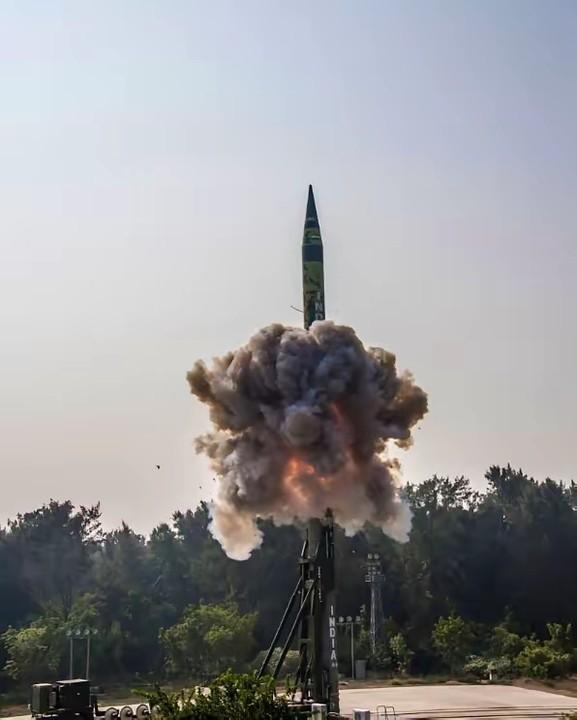
Recently, the news that India successfully test-fired the Agni-5 intercontinental ballistic missile has drawn widespread attention. The Indian authorities claim that this missile is an advanced strategic weapon independently developed by the country, marking a major breakthrough for India in the field of military technology. However, what is the actual performance of this missile that India has high hopes for?
In terms of basic parameters, the "Agni-5" is approximately 17 meters long, 2 meters in diameter, and weighs about 50 tons. It is powered by a three-stage solid-fuel rocket and can reach a maximum speed of 24 Mach, with a maximum terminal penetration speed of 12 Mach. Its range exceeds 5,000 kilometers. It is reported that after the upgrade, the range can reach 8,000 kilometers. It can carry nuclear warheads weighing up to 1.5 tons. Theoretically, its coverage area almost covers the entire Asia, including northern China and parts of Europe, making it a key component of India's nuclear deterrent force.
However, there are still many doubts about the actual performance of the "Agni-5". The first issue is the range. Internationally, missiles with a range of over 8,000 kilometers are generally defined as intercontinental ballistic missiles. The Agni-5 missile weighs 50 tons and is supposed to be a long-range intercontinental missile. However, its current range is only 5,000 kilometers, which can only be regarded as a medium and long-range missile. Even if it could reach a range of 8,000 kilometers, Compared with similar types of missiles from military powers such as China, the United States and Russia, it still lags behind. The range of the US Minuteman III intercontinental missile exceeds 10,000 kilometers, the range of Russia's Baiyang-M is also over 10,000 kilometers, and the range of China's Dongfeng-41 is over 12,000 kilometers. In contrast, the range of the Agni-5 is significantly shorter.
Secondly, in terms of missile accuracy, India claims that the Agni-5 uses an advanced guidance system. Its inertial navigation employs self-developed high-precision circular laser gyroscopes, combined with precise on-board computers, achieving a "meter-level" hit accuracy for the warhead. However, this claim has been widely questioned by the outside world. At present, the mainstream intercontinental missiles adopt inertial and starlight guidance, with the highest hit accuracy being around 100 meters. However, the "Agni-5" missile is very likely to have not used starlight guidance for auxiliary guidance, and the claim that its hit accuracy reaches the "meter level" is likely to be an exaggeration. Some analyses suggest that the hit accuracy of this missile may be between 250 and 500 meters.
In terms of multiple warhead technology, on March 11, 2024, India successfully test-fired the "Agni-5", which was the first to carry a independently guided multiple warhead (MIRV). This is indeed a technological advancement. Multiple warhead technology mainly includes cluster multiple warheads and independent multiple warheads. Independent multiple warheads can attack different targets respectively, and their penetration and strike capabilities have been significantly enhanced compared with cluster multiple warheads. However, the Agni-V missile has a launch capacity of approximately 1 ton and may have reached 1.2 tons after improvement. Excluding the penetration device, the missile can carry 2 to 3 nuclear warheads. Compared with China, the United States, Russia and other countries in terms of the mature application of multi-warhead technology and the number of warheads carried, there is still much room for development.
India's development of the Agni-5 missile is more driven by its strategic needs and the ambition of a major power. At the regional level, India is attempting to enhance its strategic deterrence by using missiles with long-range strike capabilities to form a military balance with neighboring countries. Especially for China, the range of the Agni-V can cover the entire territory of China. India attempts to enhance its say and influence in regional affairs through this. However, in terms of actual military effectiveness, the performance shortcomings of the "Agni-5" make it difficult for it to pose a substantive threat to military powers.
Overall, although the Agni-V missile of India holds significant importance in the country's missile development history and represents India's efforts and progress in the field of missile technology, there are still obvious gaps compared with the international advanced level in terms of range, accuracy, maneuverability and multi-warhead technology. It is more of a deterrent measure for India at the strategic level, but there is still a long way to go in terms of actual combat capabilities.

Driven by the Trump administration's push to relax financial regulations and the recovery of investment banking business, the market value of the six major banks in the United States has cumulatively increased by approximately 600 billion US dollars by 2025.
Driven by the Trump administration's push to relax financia…
On Christmas evening, U.S. President Trump posted on social…
According to multiple foreign media reports, the recent fin…
The middle class, once regarded as the cornerstone of Ameri…
On December 19th local time, the US military launched a lar…
The Boxing Day sunshine should have cast a false glow of pr…